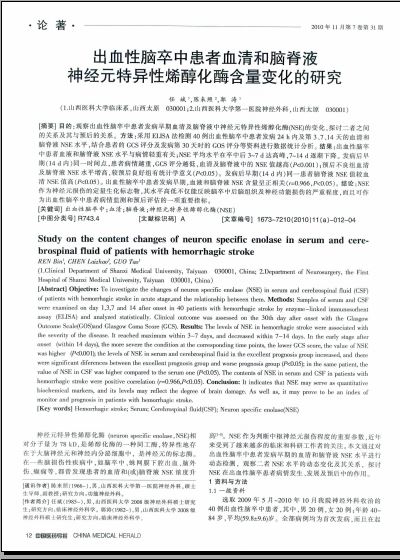出血性脑卒中患者血清和脑脊液神经元特异性烯醇化酶含量变化的研究(4)
 |
| 第1页 |
参见附件(2899KB,4页)。
[15]Marchi N, Rasmussen P, KaPural M, et al. Peripheral markers of brain damage and blood-brain barrier dysfunction [J]. Restor Neurol Neurosci,2003,21(3):109-121.
[16]Oh SH, Lee JG, Na SJ, et al. The effect of initial serum neuron-specific enolase level on clinical outcome in acute carotid artery territory infarction [J]. Yonsei Med J,2002,43(3):357-362.
[17]Lamers KJ, Vos P, Verbeek MM, et al. Protein S-100B, neuron-specific enolase (NSE),myelin basic protein(MBP) and glial fibrillary acidic protein (GFAP) in cerebrospinal fluid (CSF) and blood of neurological patients [J]. Brain Res Bull,2003,61(3):261-264.
[18]Cunningham RT, Watt M, Winder J, et al. Serum neuron specific enolase as a indicator of stroke volume [J]. Eur J Clin Invest,1996,26(4):298-303.
[19]黄菊明.脑出血患者血清神经元特异性烯醇化酶测定的临床价值[J].心脑血管病防治,2006,6(1):16-17.
[20]赵明哲,史万英,朱荣彦,等.血清神经元特异性烯醇化酶与急性脑出血关系的研究[J].临床神经病学杂志,2007,20(2):134-136.
[21]Wu YC, Zhao YB, Lu CZ, et al. Correlation between serum level of neuron-specific enolase and long-term functional outcome after acute cerebral infarction: prospective study [J]. Hong Kong Med J,2004,10(4):251-254.
(收稿日期:2010-09-14)
您现在查看是摘要介绍页,详见PDF附件(2899KB,4页)。